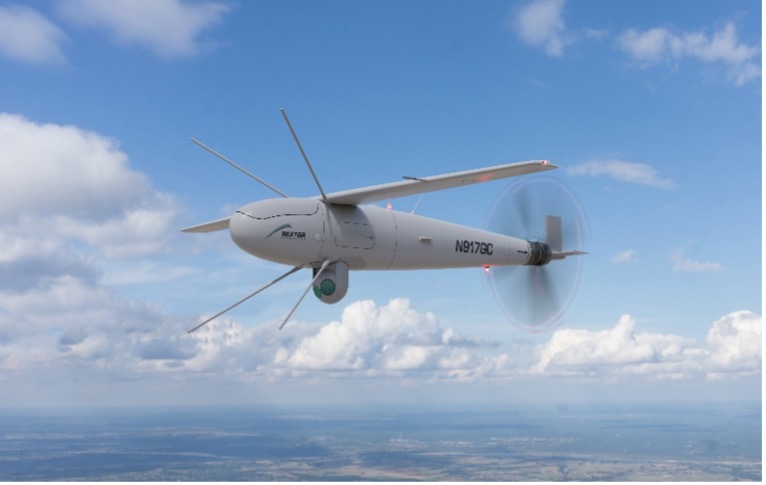Case Study
End-to-End Digital Continuity Implemented
How Baxter Aerospace Achieved Full Digitalization Within Eight Weeks.

Figure 1: The Dragonfly: A drone Baxter Aerospace is building for mapping wildfires.
Baxter Aerospace, a rapidly growing engineering and manufacturing company based in St. George, Utah, specializes in nuclear, aerospace and communication technologies. The company focuses on producing prototypes for fire commanders, complex make-to-order equipment and low-volume configurable products through a variety of processes: machining, composite work, electronics, avionics and mechanical assembly.
As Baxter Aerospace expanded, its CEO and Co-Founder, Jeff Baxter, recognized the need for end-to-end digital continuity—a capability that had proven invaluable during his tenure at SpaceX. With increasing product complexity and diversity, Baxter aimed to ensure that his company maintained efficiency and quality while keeping costs under control.

Baxter Aerospace’s Goals Were Clear:
1. Accelerate New Product Introduction (NPI).
2. Deliver high-quality products and services at optimal costs.
3. Position and prepare the company for rapid growth in 2025.
To achieve those goals, the company needed to digitize every process—from product and process design, to manufacturing and logistics.
Selecting Bridge as the Digital Manufacturing Platform
Following an extensive market analysis, Baxter Aerospace chose Bridge as its digital manufacturing platform. The selection was based on several factors:
- Proven Solution: Bridge is deployed in over 130 live plants and supports 25,000 daily users.
- Broad Scope: The platform meets all initial requirements and offers scalability for future needs.
- Cloud-Based SaaS Model: By running on the cloud, Bridge minimizes IT complexity and facilitates integration with other cloud-based solutions, enabling rapid implementation with limited upfront costs.
- Progressive Implementation: A phased approach allowed for immediate business benefits with gradual expansion.
- Cost-Effectiveness: Competitive prices ensured an attractive Return on Investment (ROI).
- Industry Expertise: Bridge team comes with a solid experience implementing hundreds of manufacturing solutions across Aerospace and Defense, Automotive, Luxury Goods and Consumer Packaged Goods (CPG).
Phase 1 Scope: Digital Continuity
Baxter Aerospace’s engineers use PTC Onshape to manage product design, simulations and release assemblies. Released assemblies in Onshape are electronically transferred to Bridge; they include eBOMs, product attributes, thumbnails and drawings.
Maintaining a continuous digital thread is a significant industry challenge and remains the privilege of relatively advanced companies. This is because it requires complex integrations between systems that were not originally designed to work together. Krzysztof Heim, Bridge’s CTO, explained, “Integrating Onshape with Bridge was truly turnkey… both solutions are open and built for integration, and they complement each other perfectly without any overlap.”

In Bridge, process engineers transform eBOMs into manufacturing Bill of Materials (mBOMs) and define execution routings. These routings include reference documents defined in Office 365 and include traceability requirements, detailed work instructions and inspection processes. Versioned mBOMs and processes are then approved via electronic workflows before entering production.
Work orders for final assemblies and intermediate products are created, scheduled and dispatched in Bridge. Tasks are assigned to production lines for:
- Composite fabrication.
- CNC machining.
- Harness assembly.
- Electronics and avionics assembly.
- Mechanical assembly, final testing, and packing.
Some key features for shop floor users include:
- Easy access with contactless cards, touchscreens and tablets.
- Step-by-step instructions with controlled specifications.
- Real-time progress tracking and immediate non-conformance reporting.
- Part barcode identification (printing and scanning).
Additionally, there is traceability reporting:
“As-designed vs. as-built” reporting covers the entire product lifecycle—from design and approval, to production and repair. Reports can be exported and shared externally without granting Bridge access.
What Happened Within the Eight-Week Implementation?
Week 1:
- The Bridge sandbox was deployed within 24 hours, with all Baxter Aerospace users and basic settings in place.
- Integration with Microsoft Office 365 enabled the use of existing reference documents, leveraging Microsoft collaboration capabilities enhanced with Bridge versioning and approval workflows.
Week 2-3:
- eBOMs and products from Onshape transferred to Bridge.
- Key users completed initial training and began configuring mBOMs, digital checklists and manufacturing processes.
Week 4-5:
- Additional users were added and the number of configured parts and processes increased.
- Line computers, scanners, printers and card readers were fully installed.
- The production server was activated and configuration data migrated from the sandbox.
Week 6-7:
- Existing parts in stock were labeled with barcodes as the engineering team was polishing the processes.
Week 8:
- The first production orders were released and executed by the shopfloor users.
Week 9: (Post Go-Live):
- 70% of production was digitally tracked by the end of the week.
Implementation support (22 men days – 176 hours) was 100% remotely delivered.
Key Success Factors to an 8-Week Implementation:
Yves Vergnolle, Bridge’s CEO, has been involved in hundreds of digital manufacturing implementation projects around the world for the last 25 years.
Yves considers that Baxter Aerospace’s quick implementation was made possible because of the following reasons:

- Shared Goals: The leadership teams within Baxter Aerospace and Bridge prioritized rapid implementation and worked collaboratively.
- Strong CAD/MDM Foundations: Onshape’s consistent and mature usage ensured clean CAD and product data, streamlining engineering data integration.
- Self-Sufficiency: Baxter Aerospace engineers configured Bridge themselves, reducing lead times and ensuring future agility.
- Seamless Technology Integration: Bridge’s cloud-based architecture enabled smooth integration with Office 365 and Onshape.
- System Stability and Flexibility: Bridge’s reliability and built in flexibility minimized time spent on troubleshooting and eliminated the need of custom developments.
Conclusion
Baxter Aerospace’s successful implementation of Bridge highlights the transformative potential of cloud-based solutions in manufacturing. Within eight weeks, the company achieved operational excellence, improved traceability and scalable processes.